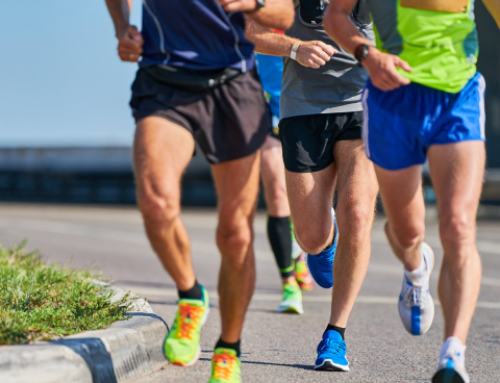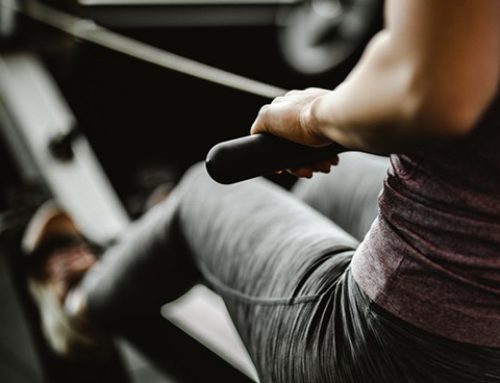Use Dynamic Stretches to Increase Strength and Prevent Injury
Performing a few Toe Touches before hitting the squat rack may feel like a time-efficient warm-up, but in reality you are just setting yourself back. Why? Because exercises like the Toe Touch do little to help performance and can actually increase the risk of injury. A proper warm-up prepares the body to take on the loads of a training session.
Static vs. Dynamic Stretches
Static stretching is often the first thing that comes to mind concerning flexibility training. It involves moving into a position that stretches a certain muscle group and holding it for a certain length of time—like bending over to touch your toes. The idea is that by gradually increasing the length of the stretch, the muscle will readjust to this length.
Overall, static stretching is an easy type of activity. It doesn’t require an intense amount of balance or control.
Dynamic stretching is quite different. Involving leg swings, high knee running and other exercise variations, it closely mimics the speed and direction of movements normally used during a workout. This makes it more effective at preparing athletes for the rigors of a training session. Unlike static stretches, dynamic warm-ups also target more than just the muscular system. Since the moves are faster and controlled, they prepare the nervous system for training while developing balance and coordination.
Developing a Dynamic Stretching Routine
The selection of dynamic stretching exercises depends on the specific training an athlete is preparing to do. In general, dynamic workouts should start with slower, more controlled movements, then gradually increase speed. This mimics the demands of a workout. For instance, a power session requires greater speed of movement than a muscle-building, hypertrophy workout. Therefore, a warm-up for a power session should be slightly faster and more explosive.
In addition to speed, athletes should carefully consider the directional ranges required for their workouts. Movements like Side Lunges need extensive flexibility in the lateral plane of movement, in contrast to Medicine Ball Slams, which require lots of rotational power. All of these factors enter into warm-up exercise selection.
Sample Dynamic Routine
Below is an example of a dynamic routine. It’s guaranteed to get you ready to move in only a few minutes. Precede every workout with a few minutes of foam rolling to warm up your muscle tissue. Then progress through the following exercises:
Diagonal Squats (10 reps each side)
With your feet about hip-width apart, push your hips back and to the right into a Squat while reaching your arms forward. Push through your heels and return to starting position. Repeat by pushing back and to the left.
Reverse Lunge and Reach (10 reps each side)
Take a step back with your left leg as you bend your right knee into a Lunge position. Reach up and back with your left arm. Hold for two seconds then step forward and switch legs.
Bend and Stretch (10 reps)
Stand with feet slightly wider than hip-width apart and toes pointed slightly out. Bend forward by pushing your hips back into a deadlifting position. Reach both arms forward to touch the ground. To add a chest stretch, return to standing position and reach both arms out to the side.
Lunge and Rotate (10 reps each side)
Step forward with your right foot and drop into a Lunge. Rotate both hands and your torso gently to the right side. Return to standing position and repeat to left side.
T-Rotation (10 reps each side)
In push-up position, rotate torso to the left and lift right arm, forming a “T” with your right hand pointed up. Slowly return to starting position and repeat on other side.
Inchworm (10 reps)
Start in a standing position. Bend over and lean slightly forward to put both hands on the floor. Walk your hands out until you’re in push-up position. Keeping your legs straight and your hands in place, walk your feet to meet your hands. Walk your hands out for the next rep.
Soldier Walks (10 reps each side)
In a standing position, swing your right leg forward for a hamstring stretch, keeping your leg straight and your chest up. Return leg back to the ground in front of you and take a step forward as you swing your left leg forward.
High Knee Run (50 feet)
Travel across the floor with a running motion, exaggerating the upwards knee drive.
Butt Kickers (50 feet)
Travel across the floor with a running motion, exaggerating the heel drive towards the glutes during each step. Focus on quick footsteps.
Side Shuffling (50 feet each direction)
Travel across the floor shuffling side to side while simultaneously swinging your arms in front of your body. Focus on staying low to the ground.
Check out our Warm-Up guide for more powerful dynamic stretches.
RECOMMENDED FOR YOU
Use Dynamic Stretches to Increase Strength and Prevent Injury
Performing a few Toe Touches before hitting the squat rack may feel like a time-efficient warm-up, but in reality you are just setting yourself back. Why? Because exercises like the Toe Touch do little to help performance and can actually increase the risk of injury. A proper warm-up prepares the body to take on the loads of a training session.
Static vs. Dynamic Stretches
Static stretching is often the first thing that comes to mind concerning flexibility training. It involves moving into a position that stretches a certain muscle group and holding it for a certain length of time—like bending over to touch your toes. The idea is that by gradually increasing the length of the stretch, the muscle will readjust to this length.
Overall, static stretching is an easy type of activity. It doesn’t require an intense amount of balance or control.
Dynamic stretching is quite different. Involving leg swings, high knee running and other exercise variations, it closely mimics the speed and direction of movements normally used during a workout. This makes it more effective at preparing athletes for the rigors of a training session. Unlike static stretches, dynamic warm-ups also target more than just the muscular system. Since the moves are faster and controlled, they prepare the nervous system for training while developing balance and coordination.
Developing a Dynamic Stretching Routine
The selection of dynamic stretching exercises depends on the specific training an athlete is preparing to do. In general, dynamic workouts should start with slower, more controlled movements, then gradually increase speed. This mimics the demands of a workout. For instance, a power session requires greater speed of movement than a muscle-building, hypertrophy workout. Therefore, a warm-up for a power session should be slightly faster and more explosive.
In addition to speed, athletes should carefully consider the directional ranges required for their workouts. Movements like Side Lunges need extensive flexibility in the lateral plane of movement, in contrast to Medicine Ball Slams, which require lots of rotational power. All of these factors enter into warm-up exercise selection.
Sample Dynamic Routine
Below is an example of a dynamic routine. It’s guaranteed to get you ready to move in only a few minutes. Precede every workout with a few minutes of foam rolling to warm up your muscle tissue. Then progress through the following exercises:
Diagonal Squats (10 reps each side)
With your feet about hip-width apart, push your hips back and to the right into a Squat while reaching your arms forward. Push through your heels and return to starting position. Repeat by pushing back and to the left.
Reverse Lunge and Reach (10 reps each side)
Take a step back with your left leg as you bend your right knee into a Lunge position. Reach up and back with your left arm. Hold for two seconds then step forward and switch legs.
Bend and Stretch (10 reps)
Stand with feet slightly wider than hip-width apart and toes pointed slightly out. Bend forward by pushing your hips back into a deadlifting position. Reach both arms forward to touch the ground. To add a chest stretch, return to standing position and reach both arms out to the side.
Lunge and Rotate (10 reps each side)
Step forward with your right foot and drop into a Lunge. Rotate both hands and your torso gently to the right side. Return to standing position and repeat to left side.
T-Rotation (10 reps each side)
In push-up position, rotate torso to the left and lift right arm, forming a “T” with your right hand pointed up. Slowly return to starting position and repeat on other side.
Inchworm (10 reps)
Start in a standing position. Bend over and lean slightly forward to put both hands on the floor. Walk your hands out until you’re in push-up position. Keeping your legs straight and your hands in place, walk your feet to meet your hands. Walk your hands out for the next rep.
Soldier Walks (10 reps each side)
In a standing position, swing your right leg forward for a hamstring stretch, keeping your leg straight and your chest up. Return leg back to the ground in front of you and take a step forward as you swing your left leg forward.
High Knee Run (50 feet)
Travel across the floor with a running motion, exaggerating the upwards knee drive.
Butt Kickers (50 feet)
Travel across the floor with a running motion, exaggerating the heel drive towards the glutes during each step. Focus on quick footsteps.
Side Shuffling (50 feet each direction)
Travel across the floor shuffling side to side while simultaneously swinging your arms in front of your body. Focus on staying low to the ground.
Check out our Warm-Up guide for more powerful dynamic stretches.











